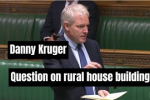
The glory of Wiltshire is its antiquity, the beauty of its landscape and the old-fashioned charm of its villages and market towns. But as the ancient monuments and the settlements show, this tranquil landscape has been used by human beings - farmed, worshipped, lived in - for all these long years. It is not a museum. It is a place of habitation and of work, and must continue as such.
The secret to Wiltshire’s prosperity over the centuries is innovation in agriculture and in other industries - most notably, in our day, in the new sectors of high-tech defence and cyber. We are perfectly situated on the road and rail line between London, Reading, Swindon and Bristol. Porton Down and Corsham are globally significant hubs of science and technology, and GCHQ is up the road in Cheltenham.
At its best Wiltshire is the ideal of modern life: somewhere to ‘live local, work global’. You can be part of the community and also part of the national and international economy. It’s somewhere that traditional trades, particularly farming, can thrive and benefit from innovation. It’s somewhere young people can aspire to a good life for themselves and their children in due course. And it’s somewhere with the prosperity and the amenities for older people to enjoy a comfortable retirement.
But a lot more needs to be done to make this a reality for everyone who wants it. We need more and better skills training, more support for the businesses that create the jobs, and more affordable housing for local families.
On skills, I support a transfer of public money from the universities sector to Further Education and apprenticeships. The Government has introduced modern apprentices which are creating real opportunities for many young people; but we need to do more. University should not be the default option for all school leavers. Many young people would do better - earn more, more quickly, with greater satisfaction and a lot less debt - if they were helped into a vocational course and a trade when they left school.
The Chancellor’s 2023 Autumn Statement included the biggest business tax cut in modern British history. This included a £4.3 billion package to help small businesses with the cost of their business rates, saving an average shop £1,650, and extending the Retail, Hospitality and Leisure relief, benefitting 230,000 properties. The Government has also raised the VAT registration threshold to £90,000. Over 28,000 businesses will benefit in 2024-25 from no longer being VAT registered.
I’d like to go a lot further, substantially raising the VAT threshold, reforming business rates and scrapping the planning laws that stop businesses expanding. And we need to do more to help individuals and families keep more of the money they earn, to encourage enterprise and ensure more money circulates in our local economy.
On housing, like everywhere in the South of England we are experiencing an acute shortage of homes for families on ordinary incomes. I support the building of new houses, especially in the west of the county where land is cheaper; but all our villages and towns are capable of a modest expansion. I find most people supportive of incremental, organic growth in our settlements to help house our growing population. What most people, including me, object to are large-scale, often ugly, developments being imposed on local communities against their wishes.
I have successfully lobbied the Government to reform the planning rules to stop developers gaming the system to do this; but more must be done to get the right sort of housing in the places and the quantities that communities need. I am a particular fan of community-led housing, such as the proposal for a Community Land Trust in Pewsey, which will create affordable housing for local families with the full consent of the neighbourhood.










